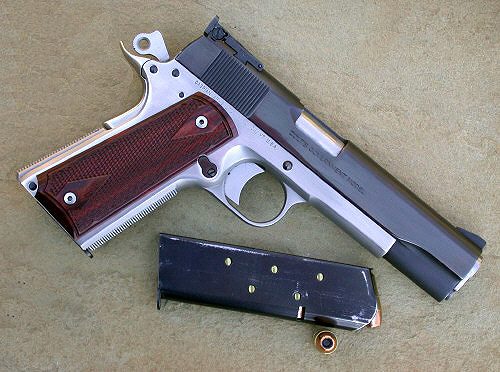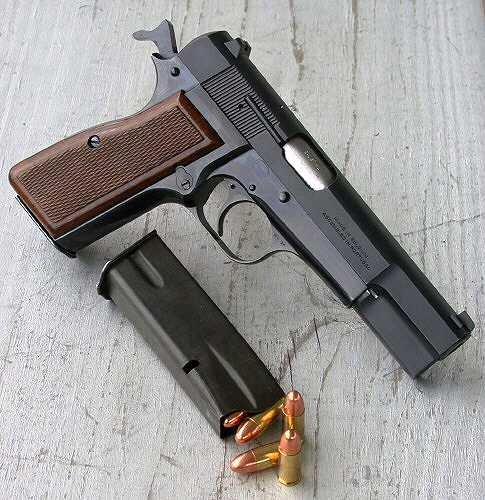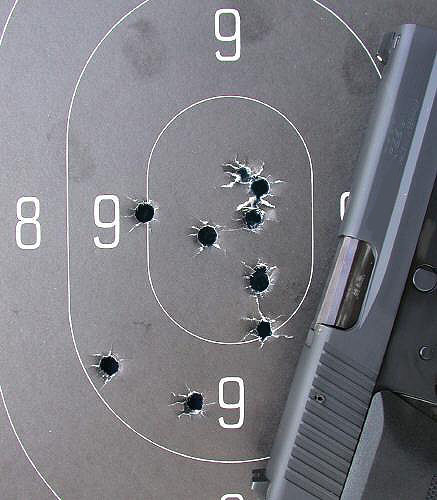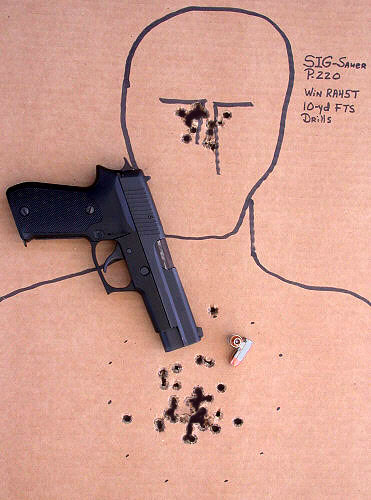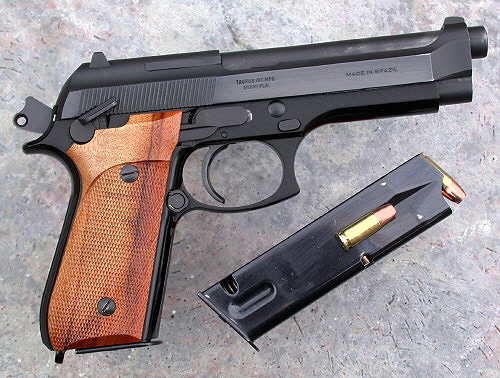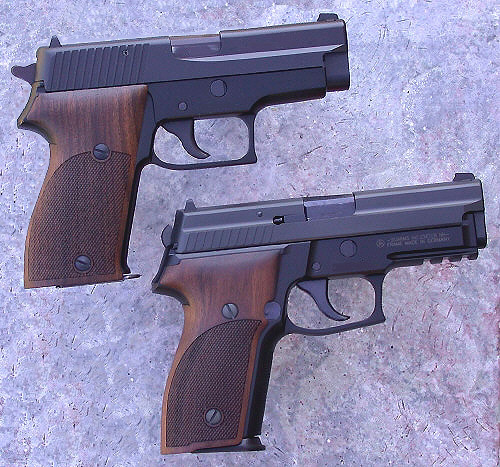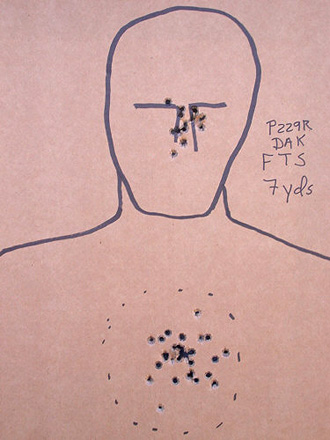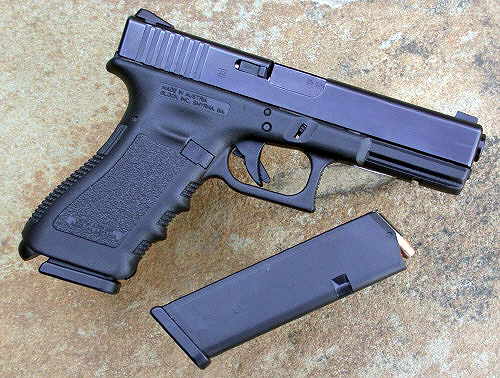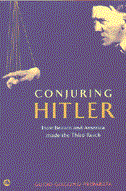| Free Republic | |
GUN, AMMO SALES UP 14 PERCENT
National Shooting Sports Foundation ^ | 8/6/07 | staff
Posted on 08/07/2007 5:45:57 AM PDT
GUN, AMMO SALES UP 14 PERCENT; $70 MILLION FOR CONSERVATION . . .
Sales by gun and ammunition manufacturers grew by 14 percent in the first quarter of 2007 compared to the same period a year earlier, according to one of the firearm industry's best economic indicators. The statistics are taken from the latest Pittman-Robertson federal excise tax collection report. Excise taxes are calculated as a percentage of wholesale receipts, paid quarterly by firearm and ammunition manufacturers, and earmarked for state wildlife conservation and habitat restoration programs.
From January through March, $70 million was generated for conservation, compared to $61 million in 2006. The latest tax collections suggest overall sales of $653.9 million during the quarter, not including retail markup or final retail sales. The increase was seen across the board in sales of handguns, long guns and ammunition.
According to a post yesterday, there’s a “shortage” of ammo in New Hampshire.............But I think it was bs..........
(and has one heck of a catalog)
Link is to web site, not the article. What is the reason suggested for the supposed shortage?
Check the copper and lead markets for the last couple of years for confirmation---
I bought some 7.62 tracers and some SS-109 from them about 2 years ago. You’re right. Fast and inexpensive.
People are getting nervous about a possible “Democratic” administration (regime), a Democratic gun ban, mosques and Islamofascists appearing in their neighborhoods, Islamofascist nukes going off in American cities and the total chaos that would bring.
Gosh, it’d be worse than Katrina. A nationwide Katrina. An outright armed revolution.
Apparently some people in the US think that they’re going to be on their own and have to take care of themselves.
Midway is a good company run by good folks. I used to order all my reloading tools and components from Midway, but when they changed their flat rate shipping charge policy it became less expensive for me to drive 20 miles over to Georgia Arms in Villa Rica to get my supplies. But with $3 gas now days I may have to reconsider. Anyway, I have a reasonably good supply of components and loaded ammo stored in my basement.
Maybe sales $ are up because prices, especially AMMO prices are up?
Wal-Mart just jumped their 100rnd “white box” prices up by about 30% in my local store and good luck finding any commercial 5.56mm out there for a reasonable price.
Yep.
I used to spend about $2500 a year at Midway, but their shipping charges made me buy local. And it seems that nearly every popular reloading component, like 5.56mm 55gr FMJ, is out of stock lately.
I hadn't thought of that, but you're right. Ammo prices have gone through the roof lately, along with the price of reloading components for those of us who roll our own. Fortunately for me I still have a lot of components that I bought back before the prices shot up, and I recycle most of the lead that I shoot at my backyard firing range. (Yeah, I live out in the sticks)
Yeah, I just checked the website of Georgia Arms where I usually buy and they aren't even showing any components on their price lists. That could mean that they're out of stock on practically everything, but their website has always been an amateurish mess and I'm hoping it's just an oversight.
I just reloaded my last batch of 1000 55gr FMJ and now I can’t find any replacements. None of my dealers can confirm when they’ll have primers, powder or bullets in stock.
The good news is the ammo industry is expecting a price slump in the near future (to hear defense industry analysts speak of it).
If prices drop, I’m stocking up (and driving prices back up ;)
i finally got the .44mag i've always wanted, ammo manufacturers have slowed production on everything else to keep up with my demand.
Exactly. Ammo prices are up, therefore tax receipts are up. Duh.
And, there is no ammo shortage in NH, at least in the common calibers, though I have heard some of the less common cartridges like 10mm are tough to get.
I wasn’t there, but the Machine Gun Shoot Republican fundraiser at Pelham last weekend was well attended, and no one reported that they ran out of ammo.
I bet magazine sales are up too. Got have some place to keep it ready. LOL.
It’s hard to get the .45LC/225 gr and .410 #4 shot for my taurus tracker/judge locally.
Correction: Wallyworld did have a few boxes of Winchester .410 3 inch shells loaded with 3- 000 buckshot pellets in stock, but my wife keeps some .410 slugs on hand for repelling boarders.
The little .410 doesn't get much respect as a defensive weapon, but IMHO an 88 grain .410 slug at 1800 fps muzzle velocity would probably ruin a BG's entire day. Or night, as the case may be.
The increase in revenue is probably not due increased sales quantities but due to increased ammo costs.
Try the bigger on-line ammo retailers (ammoman, cole, etc.) and the stuff we really need to see (Q3131/Q3131A, XM193, etc.) is out of stock or obscenely priced.
I’m still kicking myself for only picking up one case (2700 rnds) of South African .223 battlepacks. I paid around $35 a pack (300 rounds) and now I’m seeing dealers pricing it at $105 a pack (which is really out of whack and probably isn’t moving).
Even 20rnd commercial boxes are over $5 and they used to be around $2.50 a box.
If you're limited to 2.5 inch shells, Winchester has an excellent load (XB41000)which uses three 000 Buckshot. My wife handles it easily and it seems very adequate for "homeland security" in our Winchester 9410. They are available from most of the internet sales operations. I've bought them from Natchez.
Also keep in mind that at short ranges, even birdshot, by not having had much room to expand it's shot swarm is very dense, and will pack a much bigger punch than most people realize. Also, while devastating at close range, birdshot loads will minimize the hazard of overpenetration.
Switch to black powder - all you need is charcoal, sulfur and nitrates.
Yeah, ammo purchases these days can be considered a good investment.
I’ve heard some predict prices will start dropping, but I’m still loading up on the stuff that I shoot whenever I see a good buy.
I’ll check ammoman. Midway has been pretty good for me.
the truth is that ammo prices have more than doubled in the past year in reflection of rapid increases in the cost of component materials.
I own some copper stocks and the price of copper has increased quite a bit the last few years. Not only is there increased demand for brass, bullets, and powder, there's increased demand in emerging markets (China, India) for copper because of the explosion of infrastucture needed to fuel their growth.
I’m doing my part!! :)
I was going to invite myself over but I don't think I can squeeze the 4,000 mile round trip in this week.
Actually my "range" is just an informal homemade outfit with a couple of firing benches, some target stands, and a backstop made of logs. The maximum range is only 50 yards, but that's far enough for my watery old eyes anyway.
It's nothing fancy, but it beats the heck out of driving an hour each way to a commercial range and paying 5 bucks per 1/2 hour for range time. The retiree neighbors from FL who live about 150 yds away aren't real happy about the noise, but OTOH I'm not too thrilled with their thweet widdle poodle dog who yips and yaps half the night either. I'm not saying I would like to see the big black Heinz 57 dog that lives down the road a piece make a midnight snack out of the poodle some night, but I wouldn't get all broke up about it if he did.
Well, I read that article too. It said a shortage in police handgun ammo. Not good for me as I carry both a .38 and .40 S&W !
I’m not sure if I believe it either. I know there is a shortage of 7.62x39 but I think that’s nationwide as we try to outfit the Iraqi army.
So basically, my tax dollars go to pay for AK’s and ammo for some goons in Iraq while my own AK sits in my closet because ammo is artificially 1.5 times more expensive than normal. And I read another article a few days ago that said 190,000 AK47’s in Iraq are stolen/missing/otherwise unaccounted for.
http://www.freerepublic.com/focus/f-news/1876918/posts
The law of Supply and Demand will not be broken. When the Iraqis are self sufficient in ammo, the prices will come down, barring a Arab Lead Embargo..........
The .410 can be tough to find cartridges for. You might consider getting your wife a 1200 Remington in 20 gauge. The 1200 is a great shotgun to introduce newbies to the shooting sports with. It is simple and has relatively low recoil. The .410 is generally classified as an “experts” shotgun. Maybe your wife is an expert with a shotgun.
About 30 years or more ago when I was living in FL an aggressively hostile drunk tried to break down the front door of an older couple's house in the wee hours of the morning for some unknown reason. After warning the guy to back off several times (according to the old guy's testimony that is) the homeowner fired a round of .410 birdshot through the wooden door and took off most of the lower part of the drunk's face. He survived after a long stay in the hospital at the taxpayer's expense, but his face was a real mess as long as I knew anything about him.
Don't take a .410 lightly, at close range it can be deadly even with small shot, and as you said, triple ought buckshot is also available in the .410, and 3- .36" diameter lead balls moseying along at 1200 fps is nothing to sneeze at. Wild Bill Hickock put down quite a few men with a .36 caliber Navy Colt that fired just one .36" round lead ball at a lot lower velocity than the .410 buckshot load.
In the meantime, '... make plans and prepare. You never have trouble if you're ready for it.' T.R.
And why not?
Cherthoff cannot FIND the border w/Mexico, much less protect it.
We have a Remington 870 pump, it hangs with buckshot rounds in the magazine in a gun rack over the bedside nightstand where my S&W .38 revolver lies. If I have time enough in an emergency situation I would grab the pumpgun and rack a shell into the chamber, but if not I would grab the .38 loaded with Gold Saber hollow points while my wife gets to her Stevens .410 standing in the corner on her side of the bed.
If all else fails there is still the Winchester .30-30 and two other long guns in the gun rack, more centerfire rifles standing in the bedroom closet including an SKS, and 6 other handguns that are stashed out of sight around the house.
Unless an intruder can find a way to get into my log home without tripping an alarm and setting off a few floodlights, I think we could handle most hostile situations ourselves before the deputy can drive the 17 miles out here from town if I call 911. And that's providing my hard phone line hasn't been cut, because my cellphone doesn't work out here where we live.
All that may sound like overkill and/or paranoia on my part, but we have had a rash of home invasions in this general area since the illegal immigrants have moved in a few years ago and are doing most of the home maintenance and yard work around here. Their work gives them an opportunity to size up a place and it's occupants, and if they see a plum ripe for the taking they will take it or tell another crew about it and they take it. Ten years ago the local bi-weekly paper reported a half dozen arrests for DUI or other traffic violations in each edition along with perhaps a breaking and entering or assault and battery arrest now and then. Now almost every edition carries a big headline about the latest armed robbery, meth lab find, attempted murder, sexual assault, etc, etc. A local single lady was recently molested and murdered in her home not too far from here by an intruder, and an older couple's home was invaded and they were robbed and badly beaten by two Hispanic men and an anglo girl in that same general area. They haven't been caught yet AFAIK, and I don't want to be the next victim on their hit list.
Those people are right. The govt sure won't be there for us.
Scouts Out! Cavalry Ho!
I know what you’re saying about the home maintenance guys. I have the same concerns about them scouting the place.
Whenever I have work done, I make sure there are a few conspicuous shot-up targets that just happen to be laying around. I just had some tree work done and, even though the owner assured me when I hired him that he didn’t use illegals, a few guys showed up who didn’t speak English (or pretended they didn’t).
I had on my “Right Wing Gun Nut” t-shirt, some blown up IDPA targets on the garage floor, and a Gun Owners of New Hampshire sticker on the inside of my garage door. Plus some .40 brass laying around. I think they understood what all that stuff meant. ;-)
Good idea. I save my old shot-up targets whenever I get a few decent groups in a row on one. I could leave some of those lying around next time a Hispanic crew comes around asking if I need any yard work done. I don't hire anything done around here that I can do myself, and that includes almost everything I have needed up to now except a re-staining job on the logs. But who knows if they are really looking for work or just casing the joint.
A neighbor down the road left his expensive custom built utility trailer unchained one day and when he got home that evening it was gone. Another neighbor told him a Hispanic man had gone by his house earlier that day pulling his trailer behind a pickup. At least the thief was a friendly sort, he waved and gave a big smile to the neighbor as he drove by with the other neighbor's trailer in tow.
I guess I come off sounding like I'm picking on Hispanics, but I'm not. My BIL is a builder and he uses a lot of Hispanic subcontractors and their Hispanic workers. I have met and talked with a lot of those guys and they are not all bad people by any means. It's just that a lot of the bad stuff going on around here lately seems to be being done by Hispanics who often turn out to be illegals when they are caught.
I have done the same thing. I have an Ithica Model 37 riot shotgun loaded w/ #4 buckshot near the bed. I also have a .357 mag close at hand. I live in NE Bernalillo county, NM where a 911 call is a waste of time.
One of my neighbors has a sign at the edge of his property. It reads “if you can read this, you are in range” in both English and Spanish.
Winchester mod 12 fans would argue that point but I'll stick by my statement, that Ithaca 37 with bottom ejection was a one of a kind pump gun. I'm not sure if Ithaca ever made a comeback or not. I seem to remember that it was sold to somebody after it was shut down the last time but I haven't heard anything else about it.
I like the Ithica better than either the Winchester 12 or the Remington 870 because of the bottom eject feature. An Ithica pump is almost impossible to jamb.
*************************************************************************************
The baby needs milk. The car needs gas. The gun needs bullets.
Rising dairy and oil prices grab the attention of shoppers and motorists. But
the increasing price of ammunition – a consumer product the government
considers when calculating the rate of inflation – has largely gone unnoticed.
The price increases began after the Sept. 11, 2001, terrorist attacks, then
were compounded by a double whammy: the war in Iraq, which pushed up overall
demand, and growing industrial powers such as China, which bid up the cost of
needed raw materials.
The impact is widespread:
•Ammunition dealers complain of declining sales as they are forced to pass
along rising costs to consumers.
•Hunters and gun enthusiasts, who initially stockpiled ammunition when prices
spiked, are now making more of their own or shooting less.
•And police departments in the Dallas area are experiencing long delays in
shipments and having to adjust training schedules accordingly.
"It's no good to have the gun without the ammunition," said Ken Mitchell, an
ammunition dealer in Justin.
Manufacturers dramatically ramped up production after the U.S. invasion of
Afghanistan in 2001, producing about 1.5 billion rounds last year – more than 3
½ times the number manufactured in 2001, said Gale Smith, a spokeswoman for
the Army's Joint Munitions Command Center in Rock Island, Ill.
But they struggle to keep up with the demand as troop deployments continue in
the Middle East. Military spending on small-caliber ammunition increased from
$242 million in 2001 to $688 million in 2006.
The ammunition business is also feeling the pinch because of the rising price
of global commodities such as copper, brass, nickel, steel and lead.
For instance, China's torrent of construction has added to its manufacturing
capacity. And the country is hungry for resources to feed its growth. The
components needed to manufacture ammunition are also used for laying power lines
and adding buildings to wider skylines.
"We were paying $1 a pound for copper two years ago. Now we're paying $3 per
pound," said Brian Grace, a spokesman for Minnesota-based Alliant Techsystems,
the military's biggest producer of small-caliber ammunition. "Not all the
costs are being passed on. We've tried to soften the blow with supply chain
management and improved efficiency."
Despite those efforts, dealers, hunters and law enforcement officers are
feeling squeezed.
Stockpiling
Mr. Mitchell estimates that the volume of his ammo sales, which make up about
half of his business, has dropped by more than half in the past two years.
Certain rounds, such as .223-caliber, used in the Army's M-16 and law
enforcement's AR-15, have become increasingly difficult to find in the civilian
market. Supplies of the .308 cartridge, the standard round for NATO and a favorite
of hunters for its deadly effectiveness, have also tightened.
Some calibers cost only 10 percent more than a year ago; other varieties have
more than doubled in price.
When prices started to rise, savvy gun owners stockpiled all they could get,
sending prices even higher. Now dealers say that as soon as new supplies come
in, customers snap them up.
"It doesn't matter if it's 50 cents or $3, whatever's cheapest gets bought up
quick," said Robby Rucker, a manager at Southwest Ammunition Supply in
Mesquite.
He said his wholesalers raise their prices from 3 percent to 10 percent each
quarter. He expects more price increases in September.
That's a problem for Karl Pifer of Granbury, who specializes in manufacturing
designer ammunition that costs more but performs better.
"The market is moving toward lower-quality and lower-cost ammunition that
gets mass produced," said Mr. Pifer, owner of KC Precision Ballistics. "I try to
stick with the prices I've got, but when they go up, it's hard. It hits me
before it hits the customers."
When Mr. Pifer received a catalog in the mail last month for materials, he
rushed online to place orders on the good deals. But he was too late. An e-mail
in his inbox alerted him that prices had gone up since the catalog was
distributed. It was, he said, the fourth increase in eight months.
Prices of factory-produced ammunition – and increased surcharges for shipping
and handling – have gotten so high that more hunters are making their own in
a process called hand loading.
"Guys on a budget are going back to hand loading with the price of ammo doing
what it is," said Dallas resident Noel Hutcheson, 71, a retired stockbroker
who hunts quail and ducks.
Sales of ammunition components such as empty cartridges and primers have
grown at Mr. Rucker's family-run store each time retail prices for ready-to-use
ammunition have gone up.
But do-it-yourself ammunition production isn't cheap either. Someone making
his own shotgun shells is going to spend roughly a third more than last year on
supplies, said Don Snyder, executive director of the National Skeet Shooting
Association and the National Sporting Clays Association.
"There are some people who are shooting less," said Mr. Snyder of San
Antonio, whose two groups have about 3,000 members in Texas. "It's just an additional
cost to compete and enjoy our sport. There are a lot of people that jump in
and pay the tariff and do it."
Must-have item
No matter what the cost, the police need to pay. Law enforcement demand for
ammunition grew after 9/11 as departments increased their officers' live fire
training.
Several police officials said they are paying more for ammunition and
experiencing delays for shipments.
But everyone from Fort Worth to Carrollton insists that public safety has not
been compromised. Of eight departments surveyed, none has resorted to giving
deputies fewer bullets or pulling guns out of service.
The Dallas Police Department, which spends roughly $500,000 annually on
ammunition for about 3,000 officers, used to have orders filled in six weeks. Now
it takes six to nine months, said Sgt. Paul Stanford, range master for the
department.
The ammunition used in patrol rifles, identical to what the military needs,
costs 35 percent more than two years ago, Sgt. Stanford said, rising from $84 a
case to $114 a case.
And a case of 9 mm rounds, the standard for Dallas Police Department service
weapons, costs 10 percent more than two years ago – going from $98.75 in 2005
to $108.15.
The impact on smaller departments, which often don't have a special
relationship with wholesalers, can be even greater.
In Hurst, which has 72 officers, Assistant Chief Richard Winstanley needs to
plan a year or more ahead for what his staff might need. He has to be
especially proactive to keep .223 rounds in stock.
"We have to be patient," Chief Winstanley said. "Some training has to be put
off until we receive the items."
***************************************************************************
BIBLICAL THOUGHT OF THE DAY:
LEVITICUS is the third book of MOSES. It deals mostly with the duties of the Priests and LEVITES. Originally this book was called "TORAT KOHANIM", "The Law of the Priests" ...
Its present Hebrew name is Va-Yikra, the word which it begins and it means "AND HE CALLED (TO MOSES)"...
***************************************************************************
www.yearsofawe.blogspot.com
End of Days
E-mail me: Click on "View My Complete Profile" or try dovbearbarleib@gmail.com. For Most Recent Post: Click on "End of Days" immediately above.
Saturday, August 11, 2007
A Tornado Grows in Brooklyn
Yes, I believe that the expulsion of two Jewish families from the Shalhevet Pass Hevron market under direct orders from Co. Rice on Tuesday, August 7th is directly related to the tornado in Brooklyn on Wednesday, August 8th. It is the first tornado in Brooklyn ever, at least since the U.S. Weather Service has been keeping records. The tit for tat shakeup of the world associated with Gog UMagog, I sincerely believe has begun. It is a little secret of the prophets of Israel that the world will not escape the wrath of G-d when the Jewish heartland is ripped free of its faithful Jews. From what I can see from the news on the tornado is that the worst damage was in Sunset Park and Bay Ridge neighborhoods, adjacent to Borough Park.It is a message to the Jewish community that it cannot build its homes in comfort in America, thinking that the destruction of Jewish homes in the Land of Israel is an Israeli problem. Nor can you prosper while the tragedy here becomes more acute. I am in the middle of a major article on this subject as I write this update. The article will concentrate on how the sub-prime mortgage collapse and the attempt to destroy Jewish life in Yesha are intrinsically related to each other. Also since the American president is the one pulling Armilus's (Olmert's and yes Peres's) strings for the pleasure the Saudi royal family, owning an American home is not a kosher way to prosper any longer. It makes no spiritual sense that the value of an American home should rise for the benefit of American Jews as the value of a home in Yesha plummets so that the Saudis will produce abundant amounts of oil to help America prosper.
As Gog W. thickens the plot of American involvement in Jewish life here, the American prosperity machine will sink into its own red ink. You can take that to the bank. It is no accident that we are in the Years of Sukkot, a festival of temporary housing, as this tit for tat tragedy continues. In the end the tat will win over the tit because the tat is brought to you by G-d Almighty.
It is important to understand that throughout all of this that will yet transpire, feeling the pain of your fellow human being is a great repair for the soul. It helps us all become greater people who will, G-d willing, share in the Messianic Era together. We will know through experience how to avoid doing what is hateful to our fellow human being by understanding how it feels to ourselves. Facing financial distress in America because of the crashing of the value of one's home will help us better understand the distress of having one's home taken away from someone in Gush Katif with nothing but a paper shack to replace it.
If you have not yet felt that distress because you have chosen to ignore it, for the benefit of your soul may you soon feel it. If you have felt that distress, experiencing it for yourself will be even a greater tikkun. It would have been more pleasant to learn these lessons on empathy without the suffering, but our lack of merit and our stone hearted ways have seemingly left G-d with no alternative. I hopefully, bli neder, will have this next installment of "The Houses of Lavan" published this coming week.






